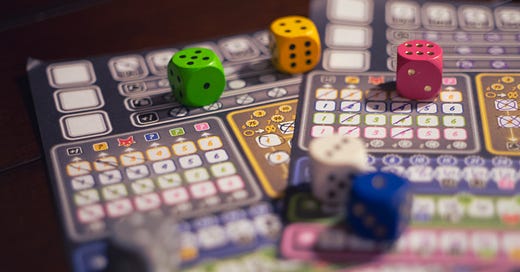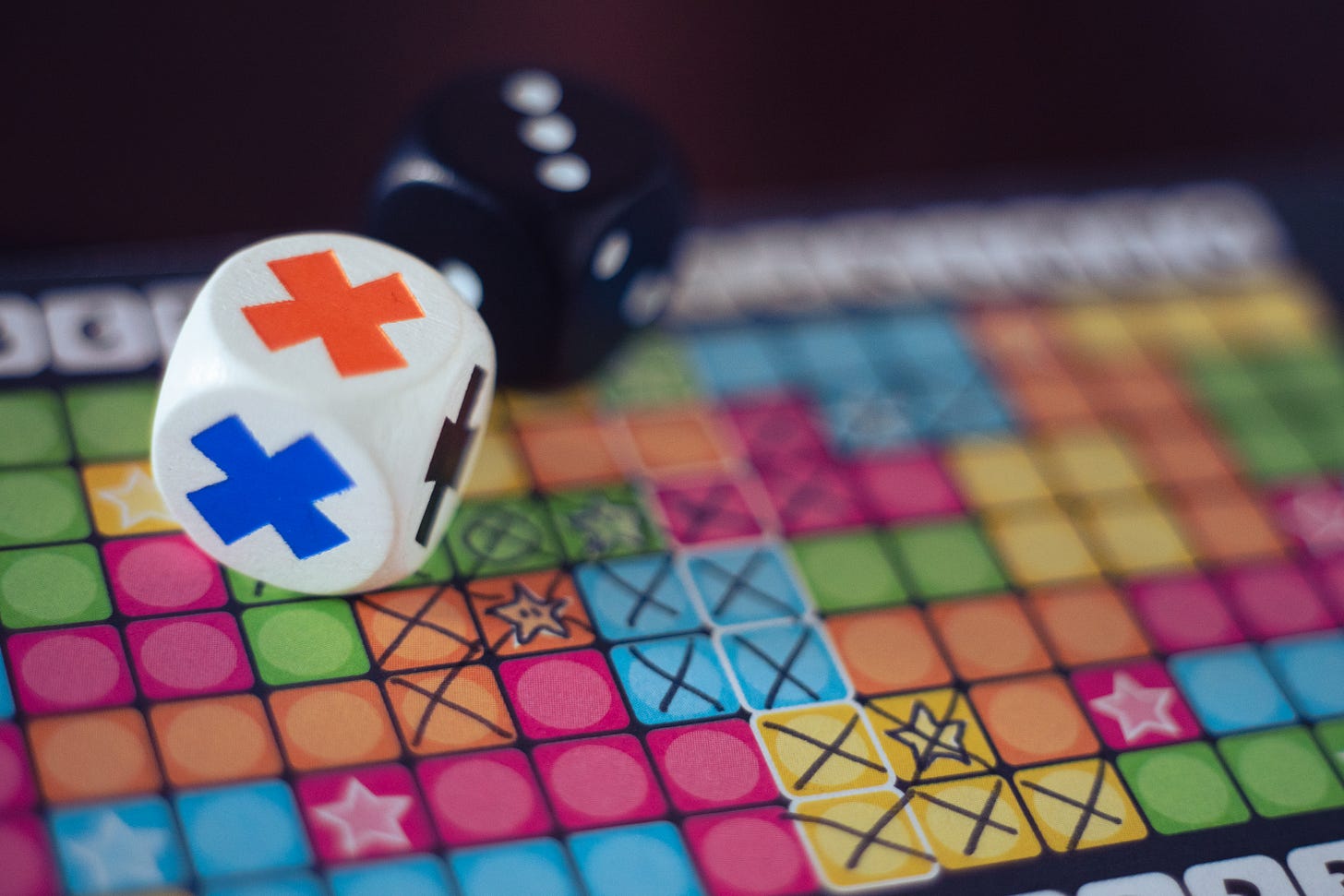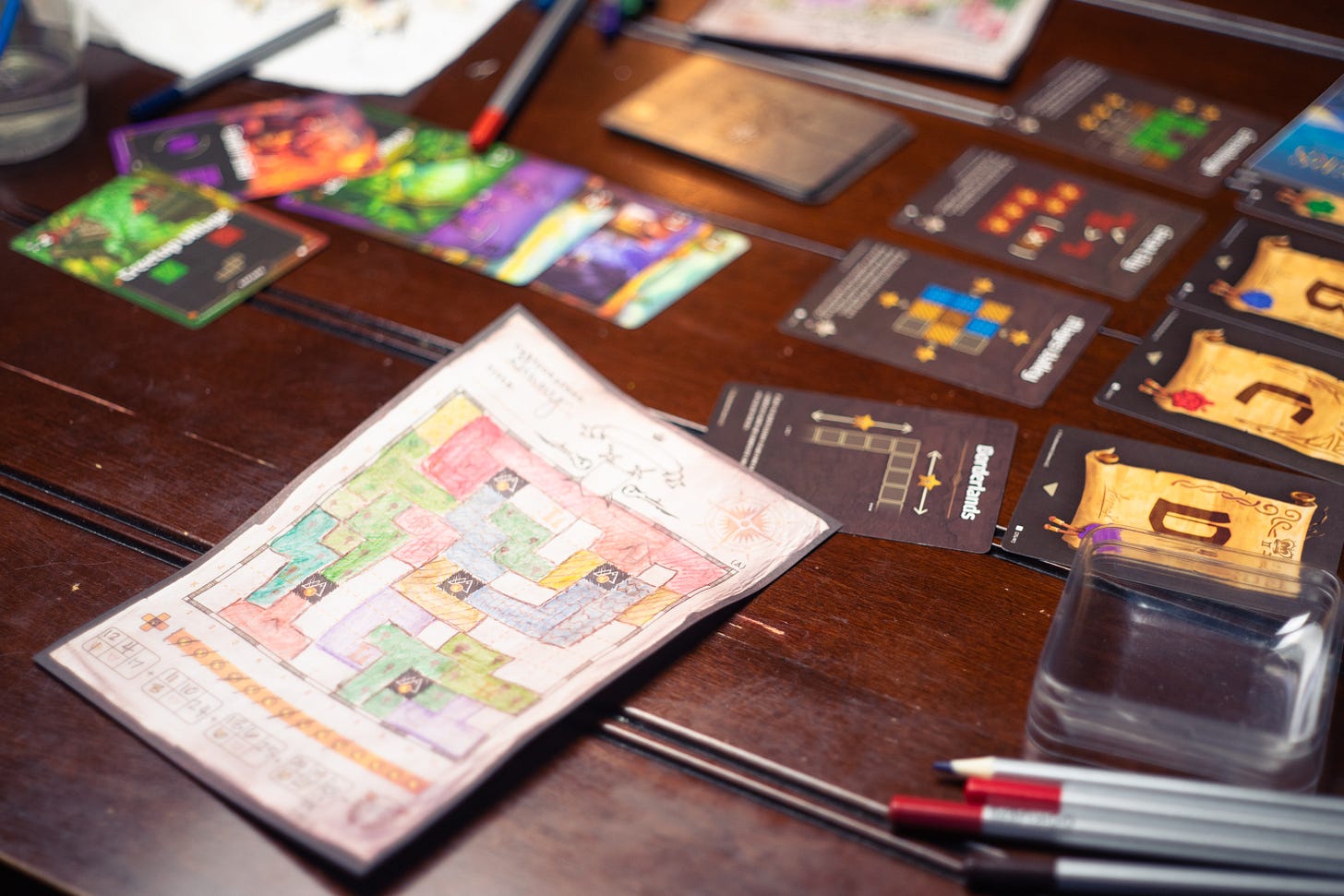The curious rise of the roll-and-write game
Rolling dice and filling squares: What brought the roll-and-write to prominence?
Not too long ago now, I wrote about the rise of the cooperative board game, tracing its history back far longer than I’d thought I would be. For over 40 years, cooperative games floated in the background of the gaming landscape. Today’s topic — the roll-and-write game — takes us on a slightly different path.
See, I know the roll-and-write game has a long history. Yahtzee, first released in 1956, remains an enduring classic. For somewhat good reason, too — it’s simple, there’s a ton of luck involved, and anyone can play. I get why Yahtzee has survived so long. I don’t think everyone needs to be playing That’s Pretty Clever (a game I do love). There’s something magical about the simplicity of a game of Yahtzee; it’s not taxing, it’s not thinky or particularly clever.
It’s not like Yahtzee was an unknown gem or a game that went undiscovered. Everyone knew about Yahtzee. It’s one of those family games you see in every home. You can play the game with just a handful of dice, some paper and a pen or pencil; nothing else is truly necessary. But this particular genre being a known quantity doesn’t negate the fact that in the late 2010s, we saw the rise of the roll-and-write game, peaking at some 2.26 percent of games released in 2020 bearing the mark of the roll-and-write.
64 years later, and the genre was seeing a strong surge of popularity. Given those numbers, I am not surprised that the pun-titled Roland Wright was among the 113 games labeled with the “Mechanism: Roll-and-Write” family on Board Game Geek released in 2020. The genre reached some sort of critical mass, and just like that, it looks like it’s already cooling off slightly.
We’ll define roll-and-write somewhat broadly here. A roll-and-write uses a randomizing element, typically dice, the results of which will dictate some action you can take on a board, which is typically either a paper sheet or an erasable board. (That’s the “write.” Otherwise, you’re just playing a normal board game.) Further, there are two schools of thought about “flip-and-write” or “flip-and-fill” games, which use a randomized deck of cards rather than dice, but otherwise typically function in the same general ways as a roll-and-write game. You’ll still use the results of cards to perform an action taken by writing on a board.
What I’d like to try to understand through this piece is pretty simple: Why did the roll-and-write genre take off in such a big way, and where might it be going from here?
The rise
The rise is stark and is something we can point at. 2013 saw just three roll-and-write games released. 2014 saw 11; 2015 saw 10; 2016, 12. It’s not even a case of fewer games being released those years than there are now, though that’s a fact with which we’ll have to contend. Instead, we have 2017 and 2018 and the genre rising; we have 2019 and 2020 and the genre exploding.
I was very much around during the rise of the roll-and-write game, which is honestly a little weird to say, but I think that underscores how quickly the genre has risen. With cooperative games, we can trace a decade of progression; with roll-and-writes, it’s maybe five years. I was writing the first iteration of this very newsletter (I wrote on Medium then, and most of what I wrote was focused on new releases. I think it’s a much more interesting newsletter now.) when roll-and-writes took off. The second issue of this iteration talks specifically about roll-and-write games, and the third is about flip-and-write games. I’m telling you — it’s weird seeing a meteoric rise happen before your eyes.
Some of the games I’d consider part of the roll-and-write canon predate that rise. To that end, I think we should establish the canon.
The modern canon
I’ll be brief here, but these are games that I’d consider largely part of the modern roll-and-write canon.
2008: Roll Through the Ages: The Bronze Age — Matt Leacock (surprise! he’s everywhere!) has an early take on the genre, because of course he does. It’s a good one.
2012: Qwixx — Light, thinky, and accessible. This is a family favorite.
2014: Rolling Japan — One of the top Japanese roll-and-writes from the era
2016: Encore! — Originally Noch Mal, a colorful, thinky German roll-and-write
2018: That’s Pretty Clever — Originally, Ganz Schön Clever. This was the singular hottest roll-and-write game. We’ll talk more about it.
2018: Fleet: The Dice Game — A dice-based take on the strategy card game Fleet.
2018: Railroad Ink — A network-building dice-chucker. What’s not to love?
2021: Rolling Realms — A playful, play-remotely take on the roll-and-write genre with some fun worlds-collide theming
2022: Three Sisters — A Euro-style roll-and-write with a rondel
2022: Long Shot: The Dice Game — A more popular implementation of its base game — a rarity
Ganz Schön Clever: The German hit comes to America
Before we try to answer the why of it all, a detour. There’s nothing quite like a game you can’t get your hands on to drive attention. Ganz Schön Clever, later released in the U.S. as That’s Pretty Clever, hit shelves in Germany in March 2018 and was quickly a nominee for the Kennerspiel des Jahres award that year. It wasn’t available in English to that point, but there was no language to the game: You roll the dice, and the colors and numbers are all you need once you know the rules.
Something somewhat odd happened, though. Despite growing attention, the game took 11 months to see a U.S. release. The myth of Ganz Schön Clever grew. There’s a reason I still call it by its German name, and there’s a reason you still see it frequently called by its German name by others, too. (Part of that reason? That’s the name emblazoned on the first and second edition box, with the English translation in smaller, parenthetical text.) That near-year sealed this game as a crucial part of the roll-and-write canon, driven in part by imports from Germany and in part by a slightly mediocre mobile app — one that I personally spent hours and hours playing, figuring out the ins and outs of the simple game.
Ganz Schön Clever is an exemplar of one of the major types of roll-and-write game: the track game, where you’ll be earning bonuses as you progress along different tracks. Those bonuses will often allow you to fill in spaces on different tracks, and if you’ve planned your turn well enough, you’ll trigger additional bonuses. The mega-turn is a real thing here.
Adam over at Punchboard had a great newsletter about track-based games recently; it’s well worth your time.
The Why
Put simply, roll-and-write games as a trend became low-hanging fruit. The cost of making a board game is not a fixed one, and companies increasingly have turned toward small-box games in their repertoire. Stronghold Games, now partnered with Indie Boards & Cards, took this strategy head on in the U.S. market, picking up Encore!, That’s Pretty Clever!, Second Chance, and Brikks in 2018 and 2019. This became a sound strategy, and I suspect they were not alone in wanting a line of games that fit a different demographic than heavier (though not always truly heavy) strategic games.
That’s hardly the only reason, of course. While luminaries like Reiner Knizia were busy designing roll-and-writes for a long time, new faces entered the fray. Wolfgang Warsch, in what we must regard as one of the greatest two years a designer has experienced to date, had The Mind, Quacks of Quedlinburg, and Ganz Schön Clever, among others, published in 2018. He followed it up in 2019 with Wavelength and The Taverns of Tiefenthal. Five games in the top 500 on BGG is no small feat, and it’s even rarer when they’re published in such quick succession. The Clever series is right at the heart of that.
Figures like Uwe Rosenberg moved into roll-and-write design, too. Second Chance, a breezy polyomino-drawing flip-and-write game, remains one of my favorites in the genre, and Patchwork Doodle does well enough transporting the idea of the now-classic two-player game into a roll-and-write. Jamie Stegmaier, the designer behind Scythe, released a roll-and-write game, Rolling Realms, in 2021. That one takes different games he’s published as Stonemaier Games and throws them all into a roll-and-write game. It’s neat.
Types of roll-and-writes
There are a few broad categories of roll-and-write games I’ll consider here, and they don’t deal with types of gameplay.
The first are standalone games. (The distinction will become more clear earlier.) They might be part of a series of thematic releases by a publisher, but they are designed and developed as wholly standalone experiences. There are many examples of these, but we’ll focus in on some select examples.
The highest-ranking standalone roll-and-write game on Board Game Geek, Three Sisters, provides an example worth considering. It fits into the classic track example, but it features some interesting strategic depth, too. Each round, dice are rolled then placed on a wheel according to their results, making this one of the rare rondel-based roll-and-write games. It’s not overly crunchy, but it doesn’t stray from a little Euro-game complexity because it’s a game of dice and paper.
The second category for consideration are games that exist as members of series. Ganz Schön Clever, once a standalone game, has spawned three direct sequels, so it fits in this category now. (Twice as Clever, Clever Cubed, and Clever 4Ever are all good in their own right, but are they necessary? I don’t know, but I like playing them.) Railroad Ink has four iterations to date, as well as a plethora of small expansions. Roll Through the Ages has two iterations (Bronze Age and Iron Age), and it even spawned a third, non-roll-and-write game in the form of Era: Medieval Age. Perhaps my favorite in the mix is Super-Skill Pinball, which has been developed into a series itself — and the format of it works perfectly, given each box has four or so different pinball tables to play on.
The third category is games that exist as a roll-and-write-specific sequel to an existing game. There are a number of these, from the complex — Twilight Inscription, following Twilight Imperium — to the simple — Lost Cities: Roll & Write, following the classic Reiner Knizia card game Lost Cities. These sorts of games typically feature slimmed-down, simplified mechanics from their progenitors, though that’s not a hard-and-fast rule.
This, for me, underscores why we can’t easily just categorize roll-and-writes like other sorts of games and come away with something meaningful. You might have a trading and negotiation roll-and-write game, a worker placement roll-and-write, a track-and-bonus roll-and-write — and the list goes on.
Perhaps too often I’ve thought of roll-and-write games as a genre, but I suspect they’d be best considered as a format. I don’t think I’m alone in having not made that distinction internally, and we see that in the rush to adapt popular games into a different form factor. Sometimes, those games are extremely good, and sometimes, they’re better than their counterparts. Long Shot: The Dice Game has far more success than its predecessor, as just one example. But as a trend, it can feel a bit too much like a money grab — or at least a publisher looking for a sure thing, and that almost certainly hinders broader success for these games.
What’s next?
The chart shows a spike and a subsequent dropping off, but roll-and-write games are still being released with some frequency. I’m among those excited for Cascadia: Rolling Hills and Rolling Rivers, which adapt the game Cascadia.
There are plenty of novel designs out there. Paper App Dungeon is a roll-and-write that comes with a spiral-bound notebook, with each page being a randomly generated dungeon. That’s quite cool. French Quarter promises to be an inventive Euro-style experience, like Three Sisters before it. Cascadito implements the system in Cascadero, both designed by Knizia, but they released simultaneously — rendering neither truly a spinoff. There’s a lot out there to explore.
The downturn, though, appears to be real and not just a figment of premature data analysis. The highest-ranked roll-and-write from 2023 is The Fox Experiment, sitting at 1,511. 2022 has three in the top 1000, with Long Shot: The Dice Game, Three Sisters, and Twilight Inscription. Only 13 games tagged as having the roll-and-write mechanic overall sit in the BGG top 1000, and only three are in the top 500. This list expands slightly if we expand to Flip-and-Write, for the record, with nine in the top 1000 and some overlap, with the three most notable games being Cartographers (#145), Hadrian’s Wall (#154) and Welcome To… (#178.) Still, none of them crack the top 100.
Are roll-and-write games as a format and not a genre here to stay? Certainly I think we can expect more games like Ganz Schön Clever, Encore and the like to see release — it’s a simple design space with broad potential. But these heavier, more involved games — will they be around? Will we continue to see a glut of releases with low impact?
I suppose we’ll just have to roll the dice, wait a bit, and see what happens.
You made it to the end! Incredible. Thanks for reading. And if you scrolled to the end, thanks for being curious how this ends. We’re all winners here. I’m not quite sure what I’ll be writing about next week, but if you have something you’d like to see, drop a comment or respond to this email. Until next time!








